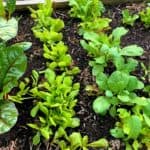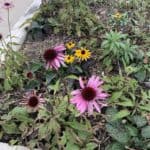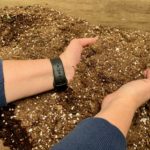Tomatoes are the quintessential Midwest garden staple. Whether you enjoy them fresh, sauce them, stew them, can them or freeze them, you cannot deny the fresh from the garden flavor can’t be beat. I’ve tried, failed and tried again at tomatoes. So don’t give up if that sounds familiar. Some years are amazing, some years are not. If you are a gardner, or hang around them, you’ve no doubt experienced or heard your gardening friends lamenting about or celebrating their tomato harvest. Indeed, the weather conditions play a huge part in our success. Over the years though, I’ve come to know these 12 truths for increasing your chances for success and maximizing your tomato harvest.
As an Amazon Associate I earn from qualifying purchases.
- Choose a sunny spot. Pick your very sunniest spot for your vegetable garden in general and for your tomatoes in particular. Tomatoes are sun lovers and more sun will mean more fruits.
- Use good quality soil and a fertilizer made for tomatoes. Tomato plants are heavy feeders and will not only require good quality soil but also regular applications of a fertilizer specifically for tomatoes.
- Allow lots of space. Tomatoes grow really fast and will grow much bigger than you might imagine. As I like to say: Trust the tags! They’ll get huge in the rich soil you’ll be providing. Crowded plants will be more susceptible to diseases like blight and allow less light to get to the fruits. In my tomato-pot garden for example, I only ever plant 1 tomato plant per large (24″ or greater diameter) pot. The same spacing applies to planting in ground or in a raised bed.
- Interesting additives in the planting hole. Gardening myths and legends abound and the same goes for planting tomatoes. Some put fish heads in their planting holes, others choose banana peels. I like to add a handful of egg shells and two mint-flavored antacids in mine. That, combined with a quality tomato fertilizer, seems to keep blossom end rot away for me and keeps my tomato plants happy. Truth or legend? You’ll have to decide for yourself.
- Plant ‘em deep. This one is hard to grasp at first (as it is unique to tomato plants), but for the best results it’s a must to plant your tomatoes very deep. Far deeper than they are planted in the pot from the nursery. You should plant your tomato transplants so that the stem is buried and only the top few leaves are above the soil. Planted this way, your tomato will develop strong roots all along the stem.
- Timing is everything. Tomatoes are warm season crops and shouldn’t be planted until all danger of frost has passed. That’s around Mother’s Day in my USDA Zone 5 garden. Even after that date, it’s important to watch your extended forecast before you plant your tomatoes.
- Provide sturdy support. Add your tomato cage as soon as you plant if it is not already in place. And please choose something sturdier than the really cheap tomato cages sold everywhere in the spring. Invest in the better ones or make your own as with the tomato-pot garden project. You won’t be disappointed and can use quality cages forever. This support will help you train your tomatoes to grow through the fencing and provide support to the plant and developing fruits, keeping most off the ground.
- Mulch thoroughly. I mulch my vegetable garden with a thick layer of straw several inches deep every year. Mulch prevents weeds that thrive in bare soil. It also helps keep the soil moist. Most important is the benefit mulch provides in keeping soil-borne diseases from splashing onto your tomato leaves, paving the way to diseases like blight that wither and kill your plants.
- Water deeply and regularly. Irregular watering can lead to blossom end rot, a calcium deficiency, along with cracking and splitting. Ideally tomatoes should receive 1 inch of water per week, provided by watering at soil level if not provided by natural rain.
- Pruning is a must. I learned this tip late, after many years of struggles with blight and other soil-borne diseases. I tried rotating my crops, until I learned that makes no difference unless you have acres of land to plant. Then I found the true solution. Once I started heavily pruning my tomatoes, everything improved! When your tomato plant has grown to around 3 feet
Cherry tomatoes ripening on the vine. Tomato plant pre-pruning. tall, prune off the lower foot of leaves. My favorite pruner will get the job done right. This will prevent blight from starting on your plants, which almost always begins in the lower leaves from the disease splashing up from the soil in a rain storm or from incorrectly watering overhead instead of at soil level. Additionally, prune or pinch off the leaves that develop in the crotch between two branches. These “suckers” will not bear fruit, they produce large leaves and take energy away from the rest of the plant. Less leaves also produces a more attractive plant, allowing more sunlight to reach your ripening fruit along with easier harvesting.
- Harvest regularly. Once your tomatoes begin to come on in summer, they
A red tomato variety and ‘green zebra’ tomato sliced and ready to enjoy. will provide you with vine-ripened glory nearly every day. Be sure to regularly walk your garden with your harvest baskets. Ideas for using your tomatoes range from right off the vine eating, to fresh eating, to canning and freezing. Check out my book for more details about maximizing your tomato success. Be sure to check out the Harvest chapter for one of my favorite ways to use up the plethora of tomatoes that is about to grace your garden. Don’t forget to grab all of those last tomatoes before the first frost in the fall. Many will ripen on your windowsill if they didn’t make it on the vine or enjoy delicacies like fried green tomatoes.
Clean it up. Lastly, like most of the vegetables in my garden, your tomato garden will fare best if you remove the plants completely after the fall frost. Removing the plants quickly and thoroughly will help prevent disease. I also do not put tomato plant remnants in my compost pile due to the opportunity for disease. It is OK to compost in city composters due to their large piles that get hot enough to kill any diseased remnants. Now that you’re all cleaned up, you can await seed catalogs and dream of next year’s garden.
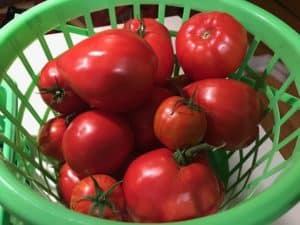
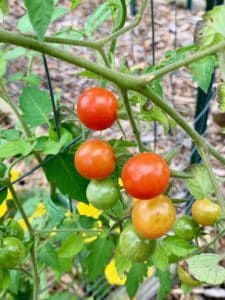
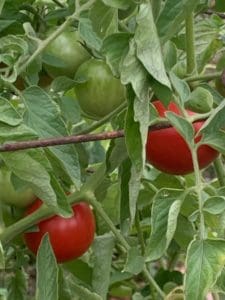
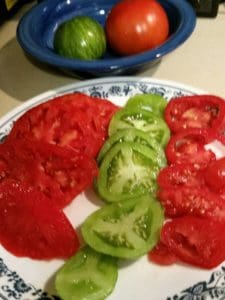
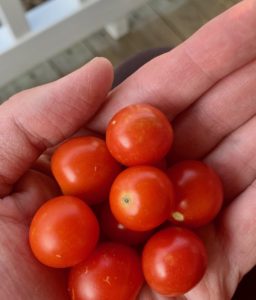 Clean it up.
Clean it up. 